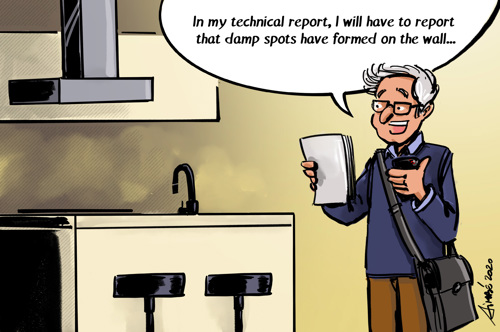- Construction Law , Real Estate, Renting and Co-ownership , Urban planning and Environmental Law
- quality control of housing , technical report , declaration of unsuitability , suitable for habitation , deficiency
The new method for quality control that will be introduced from 1 January results from the Optimalisation Decree Quality Control and the implementing act of the Flemish Government (hereafter the “new Quality Control Act”).
The Optimalisation Decree Quality Control implements the following changes in the Flemish Housing Code:
- The administrative procedure for the declaration of a home as unsuitable or uninhabitable is completely aligned with the criminal procedure of the housing inspection;
- A warning procedure is introduced, granting the opportunity for cities or municipalities to choose a ‘softer approach’;
- The rules for the inventory are being transferred from the Flemish Fiscal Code to the Flemish Housing Code;
- Finally a couple of juridical-technical improvements are put in place.
The new Quality Control Act contains the following novelties:
- The three models of technical reports are adapted to the three new categories of deficiencies in the Flemish Housing Code;
- The technical manual has received the form of a ministerial decree, making it juridically enforceable;
- Cities and municipalities can apply the new warning procedure where deemed necessary;
- The maximal compensations that municipalities can charge when issuing a conformity certificate are being raised and are indexed form now on. The municipalities can ask a compensation for a conformity examination instead of when issuing the certificate.
The Optimalisation Decree and the new Quality Control Act will enter into force in the Flemish Region starting from 1 January 2021.
From that date onwards, the new legislation will apply on all housing, meaning that whoever provides a home will have to ensure, starting from that date, that this home meets the new criteria.

1. What does this new method of quality control imply?
Taking into account the important practical consequences of the new method for quality control of housing, we will provide a bit of information on this method below.
The new legislative framework will change the way in which the evaluation occurs during a conformity examination. The technical reports are adapted to this.
1.1 The Quality Control until 31 December 2020
There are three kinds of technical reports: for independent homes, non-independent homes (consisting of regular rooms and student dorms) and non-independent homes for seasonal workers in agriculture and horticulture.
Until the end of 2020 penalty points are used for filling in these reports. The deficiencies are being divided into 4 categories. For a deficiency of category I 1 penalty point applies; for category II 3 penalty points apply; for category III 9 penalty points and for category IV 15 penalty points.
As long as a home doesn’t receive more than 14 penalty points, it can receive a conformity certificate.
In the criminal procedure all the deficiencies have to be restored today.
In the current system conformity and criminal liability are thus not in line with each other.
1.2 The Quality Control from 1 January 2021 onwards
In the new legislation, that will enter into force from 1 January onwards, there are still three kinds of reports.
The categories that exist in the current system are however limited to three categories and the penalty points will disappear.
A deficiency will be brought in a certain category, in function of the severity of the deficiency. The category immediately renders a consequence to the deficiency.
- Category I: little deficiencies that influence the living circumstances of the residents in a negative way or can potentially grow into serious deficiencies.
Deficiencies of category I shall not give rise to a declaration of unsuitability, unless the end evaluation counts more than 6 deficiencies of category I. In that case the home will automatically receive a deficiency category II. - Category II: serious deficiencies that influence the living circumstances of the residents in a negative way without causing a direct danger for safety or health.
If a housing inspector establishes a deficiency of category II, he advises automatically to declare the home as unsuitable. - Category III: serious deficiencies that cause inhumane living circumstances or a direct danger for the safety or health of the residents rendering the home as not suitable for habitation.
Starting form a category III a home will not only be unsuitable but also uninhabitable. A separate detailed report is no longer necessary. Inhumane circumstances are added as an indicator for this category, besides a safety- and health risk.
A home can receive a conformity certificate when it has less than 7 deficiencies of category I and no deficiencies of category II or III.
Rental of an unsuitable or uninhabitable home is punishable. The limit for criminal liability has been assimilated with the limit that’s established for obtaining a conformity certificate: there can’t be any deficiencies of category II or III.
2. What are the consequences of the new method?
Because the deficiency in itself and no longer the sum of the penalty points will be decisive, certain deficiencies will receive a possibility for quotation in different categories, depending on their seriousness.
Some deficiencies (like humidity for example) can be put in all three categories. Deficiencies that are now punished with 15 penalty points, will be put in category II or III, depending on the facts.
The evaluation of the individual deficiency will therefore be much more important in the new legislation.
3. What are the most important changes in terms of concrete deficiencies?
Specifically, the following changes are introduced:
- Humidity: In the current system this deficiency receives a maximum of 9 penalty points. In the new system a category II or III will be possible. The evaluation of humidity on the ceiling of common areas of a building will also be possible.
- The obligation to install smoke detectors will be implemented in the technical report on the level of the building as well as the home. This will be quoted with a deficiency of category II. To receive a conformity certificate today it is already necessary to satisfy this obligation, hence the category.
- The energy performance requirements (roof isolation and double glazing) can be fulfilled by deliverance of an Energy Efficiency Certificate (EPC). This measure is already in place for roof isolation since 1 January 2020.
- Specifically for student dorms: bicycle storage is no longer obligated, same as for the presence of a common living area.
- Also specifically for rooms is the change of the allocation of deficiencies and the excess of the objective occupation norm in compliant functions. As penalty points are no longer applied, this method is being modified. Here it is important that sufficient compliant functions exist for the objective occupation norm of the home.
4. The new technical manual
Before today there was already a manual in place with rules that have to be followed when drafting the technical reports for the investigation of the quality of a home by a housing inspector.
This technical manual is now being established by Ministerial Decree, making it legally enforceable.
Starting from 1 January 2020, this new technical manual, introduced by the Ministerial Decree of 26 November 2020, has to be applied by the housing inspectors during the conformity examinations and filling in of the technical reports.
The Flemish Housing Agency provides this new technical manual for the broad public, that is available by clicking on this link.
5. Conclusion
Starting from 1 January 2020, the new legislation for quality control of housing will apply on all homes, also the ones that are rented or made available.
The rental of unsuitable or uninhabitable homes is punishable by law. From now on, the limit for criminal liability is aligned with the limit for obtaining a conformity certificate. Thus, there can no more by any deficiencies of category II or III.
It will be a matter to ensure that all homes satisfy all the new criteria.
Furthermore, a new technical manual is in place, that has to be followed when evaluating and drafting the technical reports and that is legally enforceable





